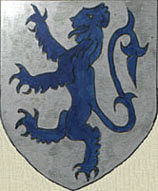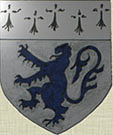Squadron Leader Joseph Forster Reed. DFC.
Skelton Schoolmaster and War Hero.
|

Squadron Leader Joe Reed, with his parents, at Buckingham Palace for the investiture by King George VI of the Distinguished
Flying Cross.
Photograph kindly contributed by his daughter, Helen.
|
Joe Reed was born in Skelton on the 17th September 1918. He was the second son of Joseph H Reed, a Blacksmith's striker and Edith
[nee Forster], who were both born in Skelton in 1891 and had married in 1913.
When Joe was in the War, they were living at 22 Dixon St, Skelton.
His ancestors prior to this were Northumberland/Durham people who came to this area to work in the Ironstone mines.
His intelligence and ability were recognised by the education system of the time and, coming from an ordinary background,
he was given the chance to attend Guisborough Grammar School.
By 1940 when the Second World War broke out, he had qualified as a schoolteacher.
He must have earlier enlisted in the Territorial Army, for after only two weeks in his new post he was called up to serve his country, first
in the Royal Artillery and then as a Navigator in the Royal Air Force, where he attained the high rank of Squadron Leader and was awarded
the Distinguished Flying Cross.
After the War he continued to live in the High St, Skelton and then at "Trimdon", Saltburn Lane. He was first a teacher at Stanghow Lane School, New Skelton and afterwards the headmaster of Boosbeck School. While at this last school, he was asked to write about his War service and luckily a copy of his handwritten
notes has been preserved by June Booth, whose children attended the Boosbeck school. They have been kindly contributed to this website by her
brother Alan Ward, who has researched Joe's ancestry. The notes are reproduced below.
The Royal Air Force lost 70,253 men in the War and of these 47,268 were in Bomber Command, the greatest casualty rate of all the Services.
Every operation was a dice with death.
A further 8,305 men were killed in training and accidents, 8,000 were injured and 9,000 ended in
German Prisoner of War Camps, but Joe modestly describes his service as if it were an everyday job:-
Anything in England which is 100 years old has lived through three Wars and that includes our school.
I remember being on Combe Bank one Thursday morning with class and taking a photograph of Paul Johns standing in a bomb crater.
That bomb was probably the nearest the school got to World War II, but near enough I am sure to make it shudder.
But many young men who went to this school also went to those Wars and sadly some never came back.
I was asked to write a little bit about the last War as I saw it.
It is rather a coincidence that just as I served in World War II, Mr Sanderson, who was head master before me served with distinction in
World War I. I wonder if among past headmasters we had one in the Boer War.
I had been a teacher for only a fortnight, when I was called up in the second group of Militia.
|

"Flying Coffins". The Whitley Bomber.
|
I remember spending my 21st birthday in barracks at Harrogate, just a few days after joining the Royal Artillery and I also spent my next
one in khaki at Battle of Britain time,on the Suffolk coast with a battery of 6 inch coastal defence guns.
After the Battle of Britain the Royal Air Force started to expand and I was able to transfer to air crew.
After about a year's training, I joined 51 Squadron at Chivenor in North Devon as a navigator on Whitley bombers to patrol the Bay
of Biscay looking for German U-boats, which at this period of the War were creating a great deal of havoc with our Atlantic shipping.
Whitleys were very slow aircraft, about 120 mph and were also named "flying coffins" on account of their rectangular shape.
We spent all summer flying partols down to the North coast of Spain and back, almost every day and each trip took 9 or 10 hours.
Apart from avoiding Junkers 88' on occasions and reporting an odd dinghy
|

Halifax Bomber.
|
in the water below, they were not very eventful days - all sea and sky.
The Squadron then moved North to Yorkshire, to Snaith, where we converted to the new four engined Halifaxes that had just come on the
scene.
My first operation on a Halifax was to Lorient on the French Atlantic coast, once again after submarines, which were based there in
pens.
During this period, I remember having breakfast with Leonard Cheshire VC at a South of England aerodrome, to which we had been
diverted, following night operations. My last trip on this tour of operations was to Stuttgart.
Then our crew were given a rest. We all split up and went to various training establishments to help train others in our trade.
I went to Hampstead Norreys, an aerodrome near Newbury.
It was whilst I was there that I attended an investituture at Buckingham Palace and had the privilege of shaking hands with King George
VI and exchanging a few words with him.
[The Distinguished Flying Cross was awarded for -
"an act or acts of valour, courage or devotion to duty whilst flying in active operations
against the enemy".]
During this rest period we instructed navigators and bomb aimers in their
|

|

Mosquito Bomber.
|

Air Ministry, 15th June, 1943.
ROYAL AIR FORCE.
The KING has been graciously pleased to approve the following awards:-
Distinguished Flying Cross.
Flying Officer Joseph Forster REED (47686), No 51 Squadron.
|
Gazetted for the DFC.
|

Distinguished Flying Cross.
|
work and accompanied them on their initial trainingflights.
We briefed them for cross country exercises and marked their logs on their return.
Just 12 months later I returned to operations flying Mosquitoes with 692 Squadron, based at Gravely, near Huntingdon.
These were wonderful aircraft - wooden fuselage and wings, fast at 300 mph, high ceiling at 35,000 feet [although we generally bombed from
around 16,000 feet], a good range [Berlin, with external fuel tanks] and a good bomb.
A tour on Mosquitoes ws 50 operations, as against 30 on heavy bombers.
I had a good pilot, Tommy Beal [we still exchange Christmas cards] and we did everything together and I think visited every town in
Germany of any significance, including Berlin nine times.
The tour ended in August 1944 with Kiel, having started in April. We generally flew 2 nights running, sometimes 3 as far as weather
conditions allowed.
We were well fed, morale was high, but the routine was a little monotous - get up in the morning, look at
the battle order, do a night flying test [NFT], look at the Met Office briefing, do a flight plan, eat [eggs and chips], relax on
the bed for a while, report to the flight office, draw a parachute, transport to dispersal, into aircraft, airborne, set course,
on target, return, debriefing, cup of tea and bed.
When not operating, lounging in the crew room, drinking in the Mess or, if you felt like it, down the local.
|

|
After that tour, I went as Station Navigation Officer to Barford St John, a Mosquito training Unit, and stayed there until
the end of the War, when I was demobbed in November 1945, after 850 flying hours and 84 operations.
After the War Joe returned to Skelton and a teaching post at Stanghow Lane School.
In 1947 he was married locally to Thomasina S A Ferguson, a native of Birkenhead, Merseyside.
In 1949 they had a daughter, Helen.
After retiring he lived for a time on the Hills above Skelton.
He then moved to the Lake District, before going to be close to his daughter in Leamington Spa, Warwickshire, where he died in November 2005.
|
|
JOE REED AT STANGHOW LANE SCHOOL.
|

1949. [Top L to R] H Hayes, D Hodgson, D Beckham, Eric Sturman, Joe Pearson, Joe Reed, K Jack, P Speak.
[Bottom] John Ward, H Antill, D Chapman, D Sedgwick, Frank Ward.
|

1949. [Top L to R] A Tilley, T Calvert, B Ness, D Preston, B Bloomfield, ?, J Reed, H Breeze.
[Bottom] J Templeman, G Templeman, D Lowe, ?, P Ferris, B Addison.
|

1950.
[Back row L to R] D Sedgewick, F Ward, J Keeler, B Evans, D Hodgson, A Walker, K Bennison, J Simpson.
[Middle] Mr W Bonas, headmaster, I Cross, A Peacock, E Hewling, S Laughton, M Matthews, Mr Joe Reed.
[Front] P Wilde, Y Buck, B Walker, A Ebbs, F Miller, D Payne, P Gosling, M Teasdale, J Lacey, J Dick, E Drury.
|

1953.
[Back L to R] Freddie Antill, P Bannister, Wilf Green, Gordon Bendelow, Ronnie Robinson, Hickey Smith, Bob Ellingham, John Main,
Joe Reed.
[Front] Geoff England, Malcolm Mogridge, Ian Carter, Hockey Stephenson, Ronnie Garrett.
|

1956.
[Back L to R] M Holt, R Bramley, M Marley, J Hessey, N Morley, G Laker, Joe Reed.
[Front] B Snaith, I Parkes, G Hudson, B Kime, A Robinson.
|

1956.
[Back L to R] Mike Crossman, John Hessey, Neil Morley, Michael Holt, Derek Dauncey, David Brown, Keith Carter, Peter Hill, Maurice Drury.
[Middle] Ian Parkes, Alan Cummins, Les Smith, Francis Batterbee, Eunice Smurthwaite, Valerie Snaith, Irene Codling, Dorothy Hodgson,
Pauline Ridsdale, Janice Simpson, Brian Duncan, Alan Mogridge, Geoff Hudson.
[Front] Jean Agar, Ann Wilson, Janet Cook, Josephine Catnach, Margaret Wright, Joe Reed, Joan Robson, Sheila Thurlow, Barbara
Foulsham, Sheila Harrison, Pat Smith.
|

1959. Mr Edmonson, headmaster leaving presentation.
[Left to Right] Joe Reed, Mrs Edmonson, Mr Edmondson and son [seated], ?, Marjorie Crossman, ?, Robin Jackson, ?, Brenda Dale,
Rita Sturman, Sheila Garland.
|

1960. [Top L to R] Derek Carter, Robert Wilson, Keith Crooks, Pat Hopkins, Pauline Marshall, Brenda Readman, Ronald Chapman,
Christopher Boyes.
[Front] Eileen Laker, Carol Boyes, Lynn Johnson, Vera Thomas, Joe Reed, Joan Robinson, Wendy Jackson, Margaret Brown, Yvonne Hurn.
|
IN 2012 A MEMORIAL WAS UNVEILED IN GREEN PARK, LONDON TO TO THE HEROES OF BOMBER COMMAND.
A MEDAL WAS BELATEDLY ISSUED FOR ALL WHO HAD TAKEN PART.
BUT MOST WERE DEAD, INCLUDING OUR OWN JOE.
AN ETERNAL SHAME ON THE NATION THEY SAVED.

|
|



